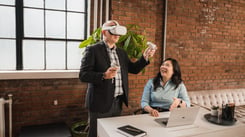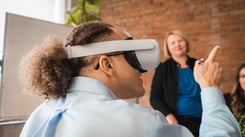VR and AR seem made for the architecture industry. They provide a window onto something that doesn’t exist yet or place a digital object in the real world - pretty apt for the ways architects are trying to communicate their vision. But many firms are challenged with how to adopt the right solution that will be practical and functional in their practice. Manage those challenges with the right VR for Architecture software.
The Right VR for Architecture Software
We’ve talked to many early adopters, beta testers and tradeshow attendees who have tried adopting VR and found a lot of challenges along the way. Sure, the scenes are immersive and get clients talking, but creating them has been a long process, and presenting them to clients has brought challenges with IT setups and headsets. The answer to clearing all those hurdles is selecting the right VR software for architecture - and the right one should follow your workflow and allow you to create and present VR to your clients as part of your everyday practice. To find the right software, break down your workflow and look for something that matches each phase.
Headsets and Presentations
Let’s start from the desired end point - after all if we say “Virtual Reality” to any client, they are going to picture a headset. Headsets like the Meta Quest 2, starting at about $550 are a great investment (see our rundown on the best VR headsets for architecture, here). But the simplest headset is still useless without outstanding content and even more importantly, getting the content onto the headset in a way that allows you to show it to your client without technology getting in the way of your architecture presentation.
The software solution you choose should be able to manage final presentations in your office, at your client’s and remotely. In your office where you can control the environment, you may be able to use a system that requires motion sensors and more, but VR that is self-contained in something like the Quest headset is much simpler to take on the road with you to your client’s location. Some VR software solutions, like Yulio, also let you bind a headset to your account so that you can control the content on it remotely. This is especially valuable over a longer-term project where you may have update meetings or be sending new plans repeatedly.
When you are looking for the right software for your architecture practice, give thorough consideration to your presentation needs and look for a solution that can meet them. Without this final piece in the workflow being relatively simple, your chosen VR solution may not be used as often as you would like.
Creating Your Design Presentation in VR
If we take the next step upstream from presentations and look at creating VR, we find the area that a lot of firms have found challenging in their digital reality experiments to date. Creating VR in the traditional way - you have to create renders and stitch them together - is time-consuming. Plus, on larger projects, you might need someone to go in and add a floorplan or navigation, and generally edit the render so that it’s usable. It will create a ‘wow’ moment for your clients but ends up being reserved for special pitches as it’s just not sustainable or profitable to do every day. That’s why you need to be able to create VR and AR with the tools you already know.
Look at what CAD software you’re using today and find something that is compatible directly from Revit, Sketchup, Lumion or whatever render engine you’re using. The Yulio engine will automatically take your file, and add floorplan navigation and point to point navigation so that virtually any member of your team can create VR for any project. Look for an option that allows anyone in your organization who can use your CAD engine to create VR - you’ll avoid expensive machine time, and let your senior team remain focused on design problems while still using VR on every pitch. When everyone in your company can create VR, your software costs are better amortized across pitches, and over time become better integrated into your workflow so that the VR architecture software you chose gets used more often.
Consider Design Fidelity, Too
All renders should be useful but only very few need to be beautiful. Sometimes you may be avoiding VR presentations because you want to confirm direction or feasibility and are worried your client will get bogged down in colors and finishes. VR can fit here too - your chosen software should allow you to present designs at different levels of fidelity. You can use VR to pop in and out of a neutral or ‘cardboard’ design with some programs for quick and immersive concept presentations. VR should be functional not just for realism but also some of what it’s best at - confirming size, scale, sightlines and flow.
Storytelling with the Right VR Software
Creating your presentation from renders is the first and perhaps largest part of the presentation puzzle, but you may also find that the best design presentations need some enhancements. Your chosen VR software solution should allow you to do that quickly and easily. We’ve all seen designers creating painful presentations with screencaps in PowerPoint so they can be annotated - and it takes clients out of the moment. Practical VR software should allow for enhancements right inside the scene.
You may want to consider the enhancements that could be most useful in telling your story before you look at software solutions - some options include:
- Audio - both ambient and voice-over for design discussion
- Video - both for realism (moving shapes etc) and to be able to insert a greenscreen video of someone welcoming clients to the scene etc
- Images - present alternate materials etc. without leaving the scene
- Links - do you want viewers to be able to click to other information on materials or design inspiration articles etc
- Floorplan - useful to orient oneself
- AR - while AR is much more than an enhancement (see our tips on using AR in your presentations) you can think about choosing a VR solution that lets you bring architectural elements into the real world as part of your overall design storytelling toolkit.
The Best VR Software Follows Your Workflow
When implementing changes and solutions in any area of your practice, you’ll find the level of opposition increases when more elements of change are added. You can inadvertently slow your team down from how they are used to doing things, even if something is meant to improve efficiency. The best way to avoid that trap, and to avoid a VR investment from becoming an unused experiment, is to map your workflow and choose a software solution that fits your team. We find it useful to look at it in three key phases: Create, Enhance and Present. When you find the VR software solution that fits your team, you’ll find presenting in VR can become simple for every client and reap the benefits that sharing your vision in VR brings.







